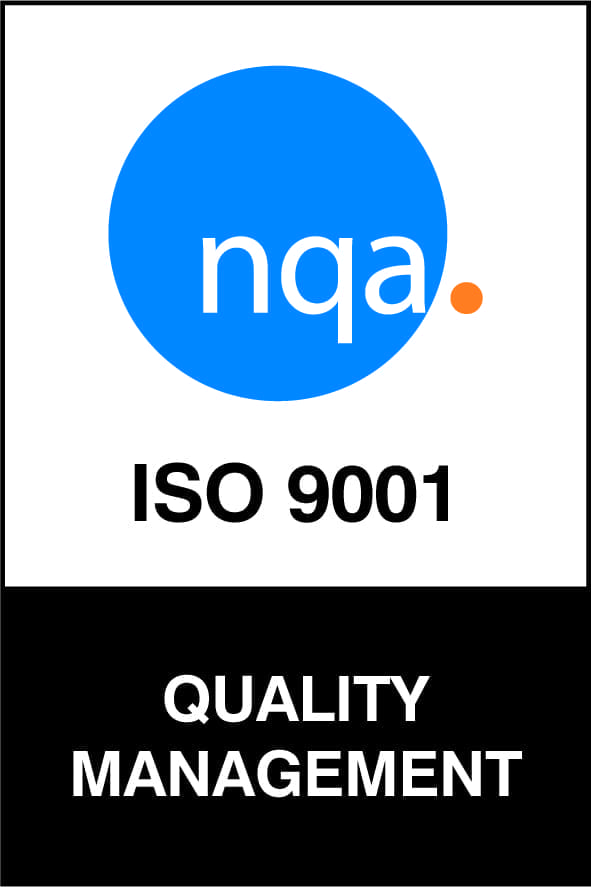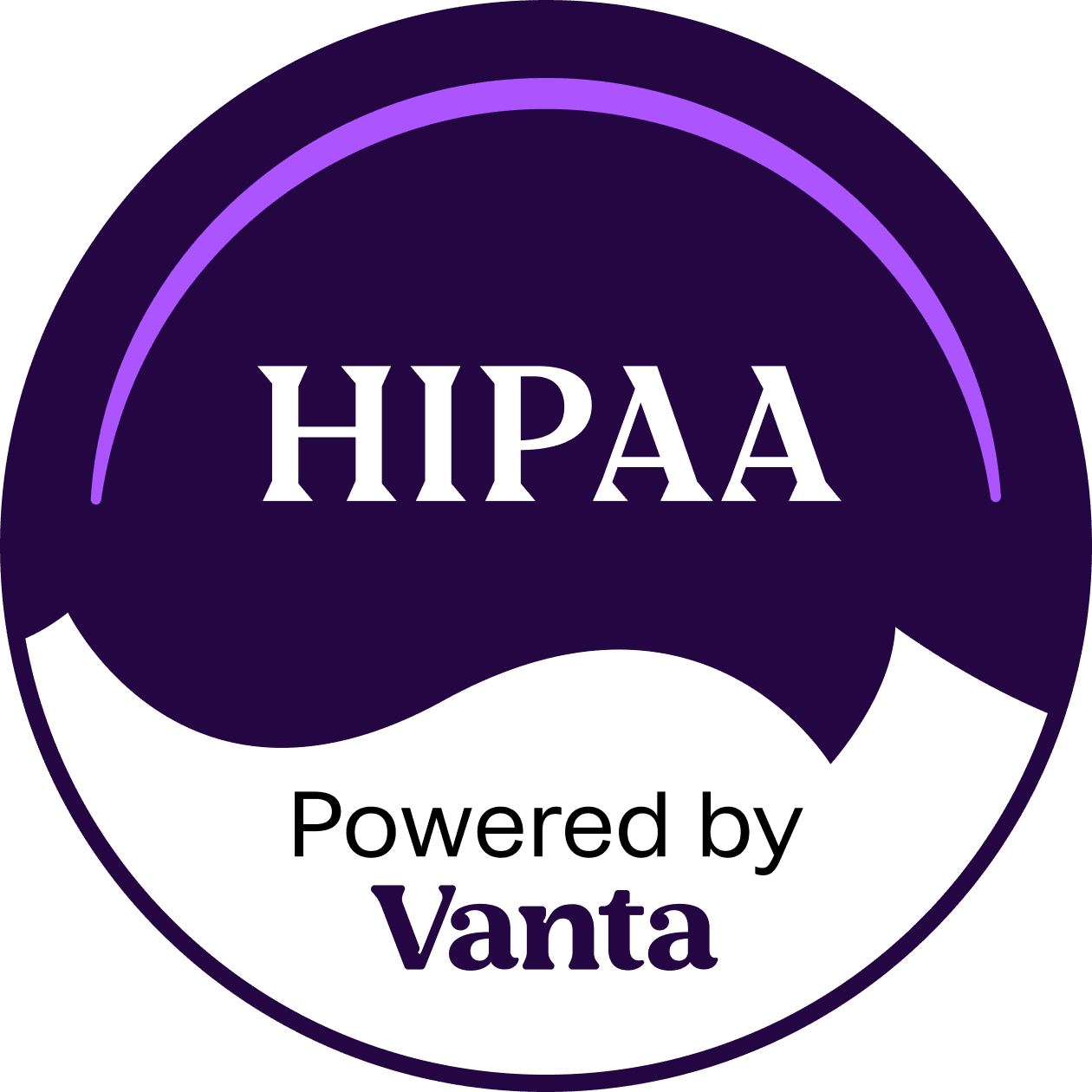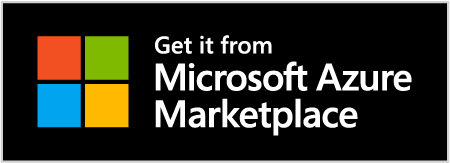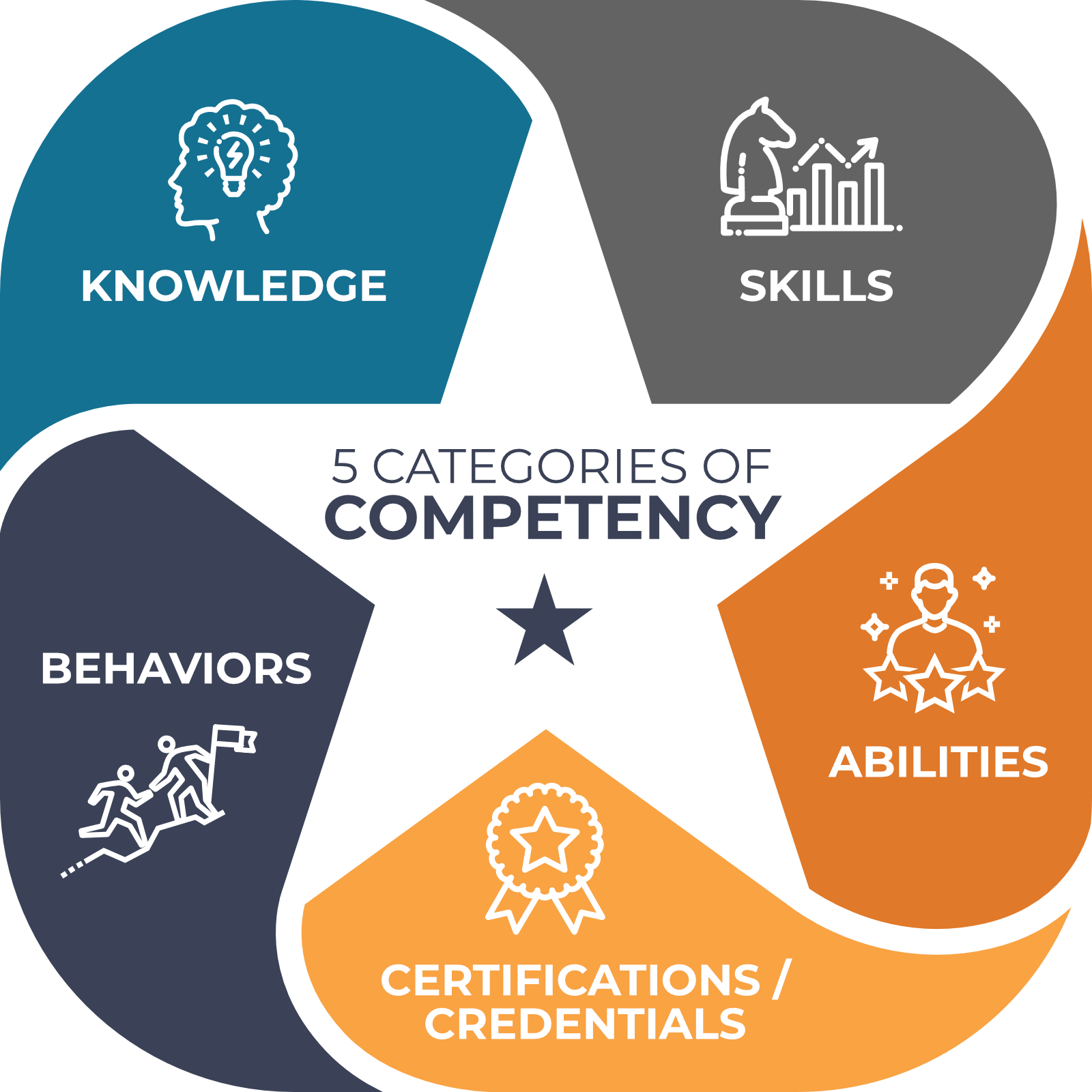Competency Manager
A customizable solution for competency management with real-time progress tracking and audit-ready reports.
Competency Manager
A customizable solution for competency management with real-time progress tracking and audit-ready reports.
CABEM’s Competency Manager Just Got Smarter
Now with the power of AI, the CABEM Competency Manager is a configurable platform that allows you to model your organizational hierarchy to assign, prioritize, track, audit, and report activities by role, team, or organization.
If training and quality assurance are top priorities for your organization, but your competency-based training system doesn’t feel credible, isn’t repeatable, or leaves your team uneasy as they prepare for audits, CABEM can help. Check out our Competency Manager FAQs to learn more.
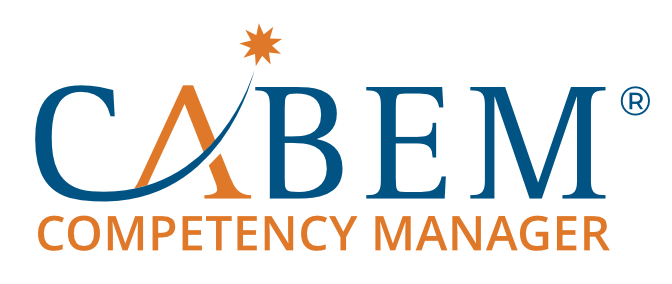
A Customizable Competency Solution
- Create a stepwise curriculum, a one-off learning activity, or documentation/ credentialing task.
- Assign to individuals or groups.
- Approve – Automatically initiate an approval process (e.g., evaluation, manager sign-off, self-attestation, uploads).
- Recognize – Make it official by awarding certificates and badges.
“CABEM has everything we were looking for from an LMS. On top of that, the competency management features have boosted our efficiency and work quality.”
Telemedicine Director, Behavioral Health Group
5 Key Competency Categories
Knowledge: Building a solid foundation of fundamental principles, regulations, and best practices relevant to each role ensures that employees are well-informed and capable of making informed decisions. This foundational knowledge is crucial for compliance and effective performance.
Behaviors: Cultivating positive behaviors fosters a productive and ethical workplace culture. Encouraging behaviors such as integrity, accountability, and collaboration ensure a supportive environment that aligns with organizational values.
Credentials: Obtaining and maintaining professional certifications and credentials validate an employee’s expertise and compliance with industry standards. This enhances credibility and ensures that the workforce meets regulatory requirements.
Skills: Developing essential skills allows employees to perform their roles effectively. This includes technical and soft skills such as communication, teamwork, and problem-solving, which are necessary for the successful execution of tasks and collaboration.
Abilities: Enhancing inherent abilities such as leadership, decision-making, and adaptability is key to thriving in dynamic environments. These abilities help employees handle challenges and drive innovation within the organization.
The CABEM Competency Manager, competency-based training, is a workforce development system that provides an at-a-glance view of an organization’s competency framework for every location, department, role, and individual across the enterprise. CABEM recognizes that competency-based training is attained by methods not typically embraced by the functionality available within an LMS, such as online training and tests. People become competent through not only formal but experiential learning.
The competency-based training platform aggregates multiple completion methods for learning and development, such as witnessing, approvals, and traditional LMS techniques. It eliminates the need for spreadsheets and filing cabinets with document libraries to retain user records and information for current and past years. The platform identifies learning/development pathways to help organizations comply with quality management standards with document tracking, archived training materials, version control, and more, allowing organizations to pass audits easily. It provides the ability to manage risk, automate certifications, and publish reports on actionable data, improving efficiency overall across the enterprise.
User Profiles and Dashboard
Easily accessible and built to manage workflows and priorities.
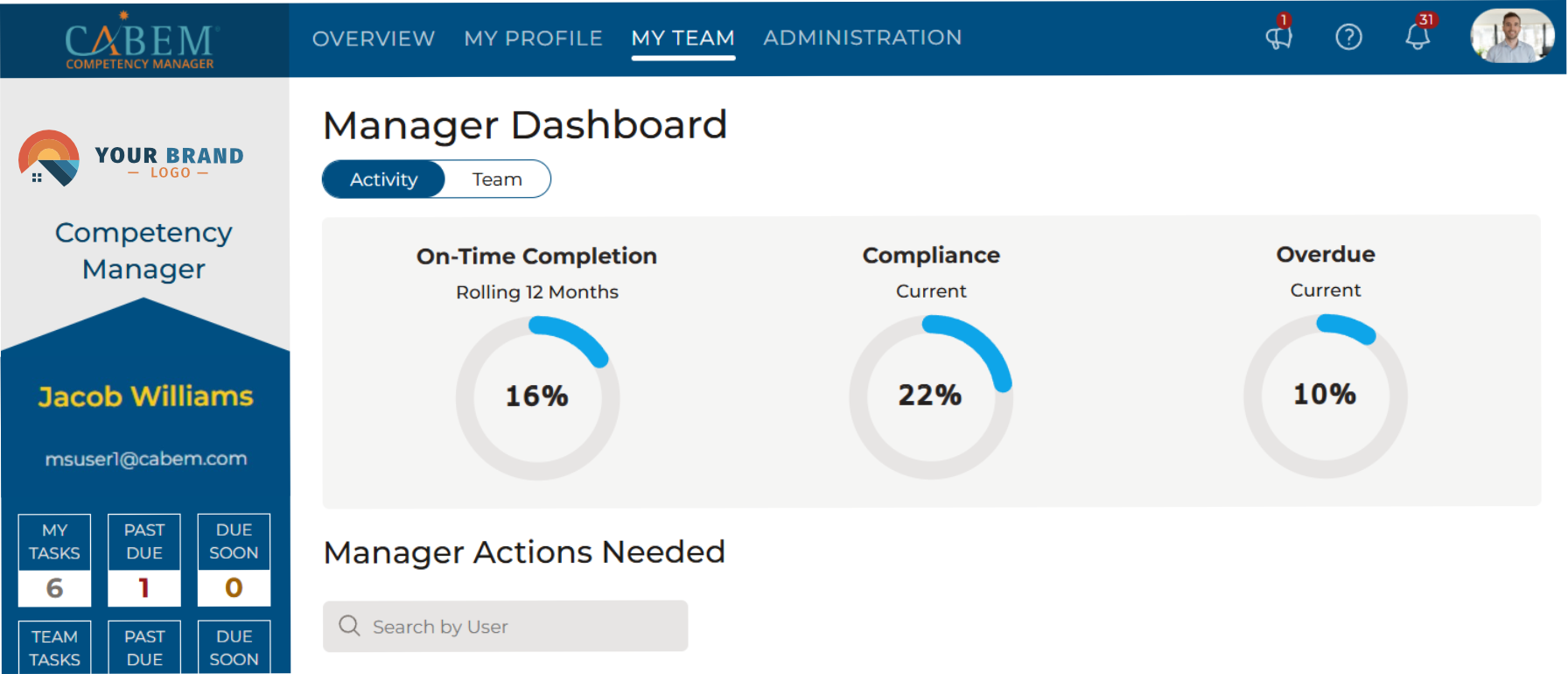
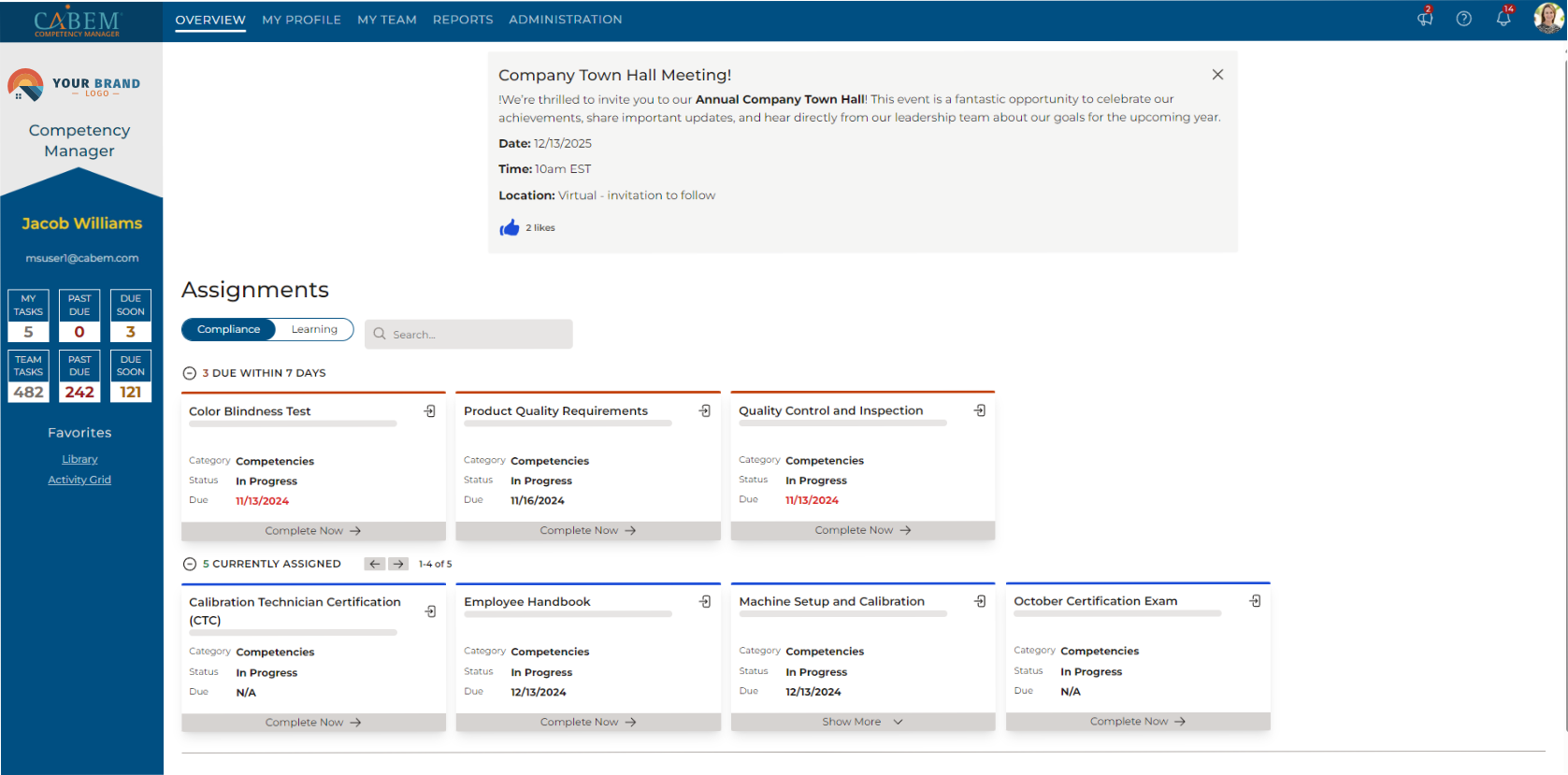
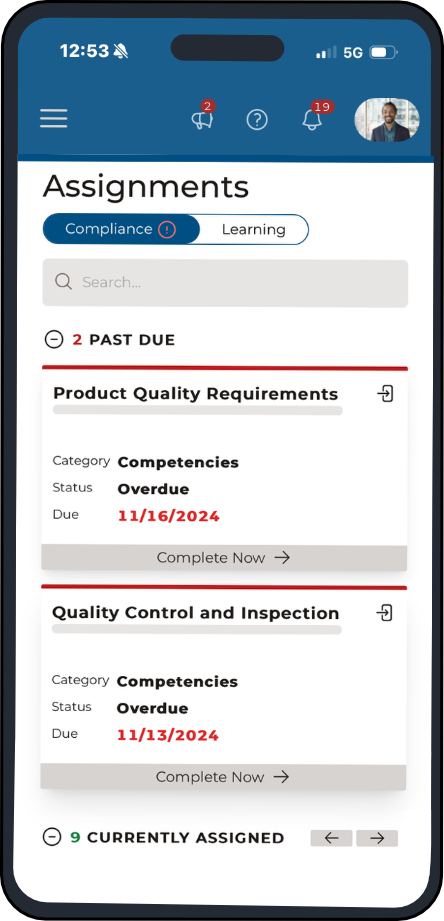
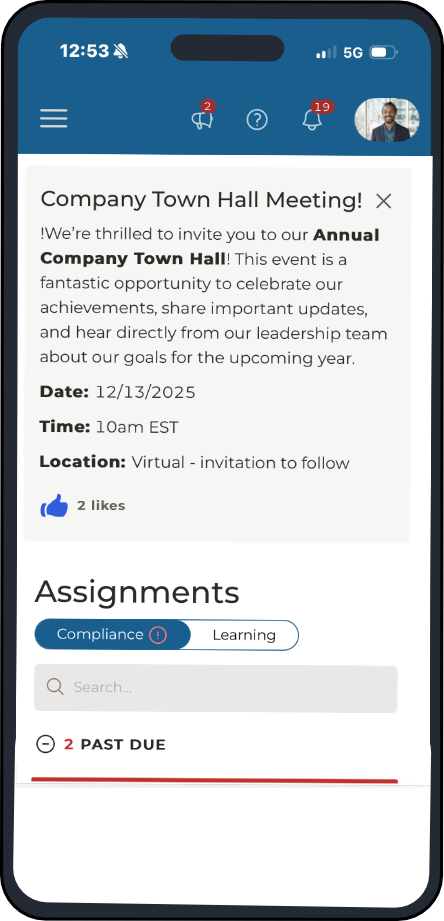
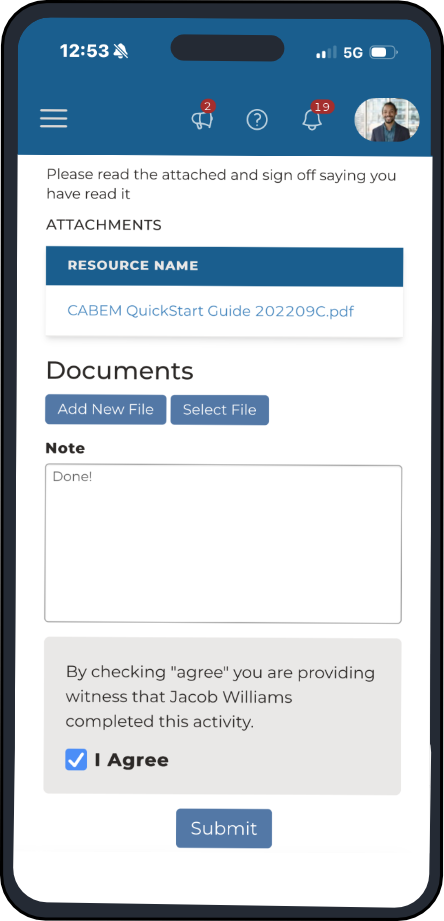
Manage Activities
Assign tasks, requirements, training, or competencies according to the needs of your organization. You can configure the system to support the unique needs of your organization.
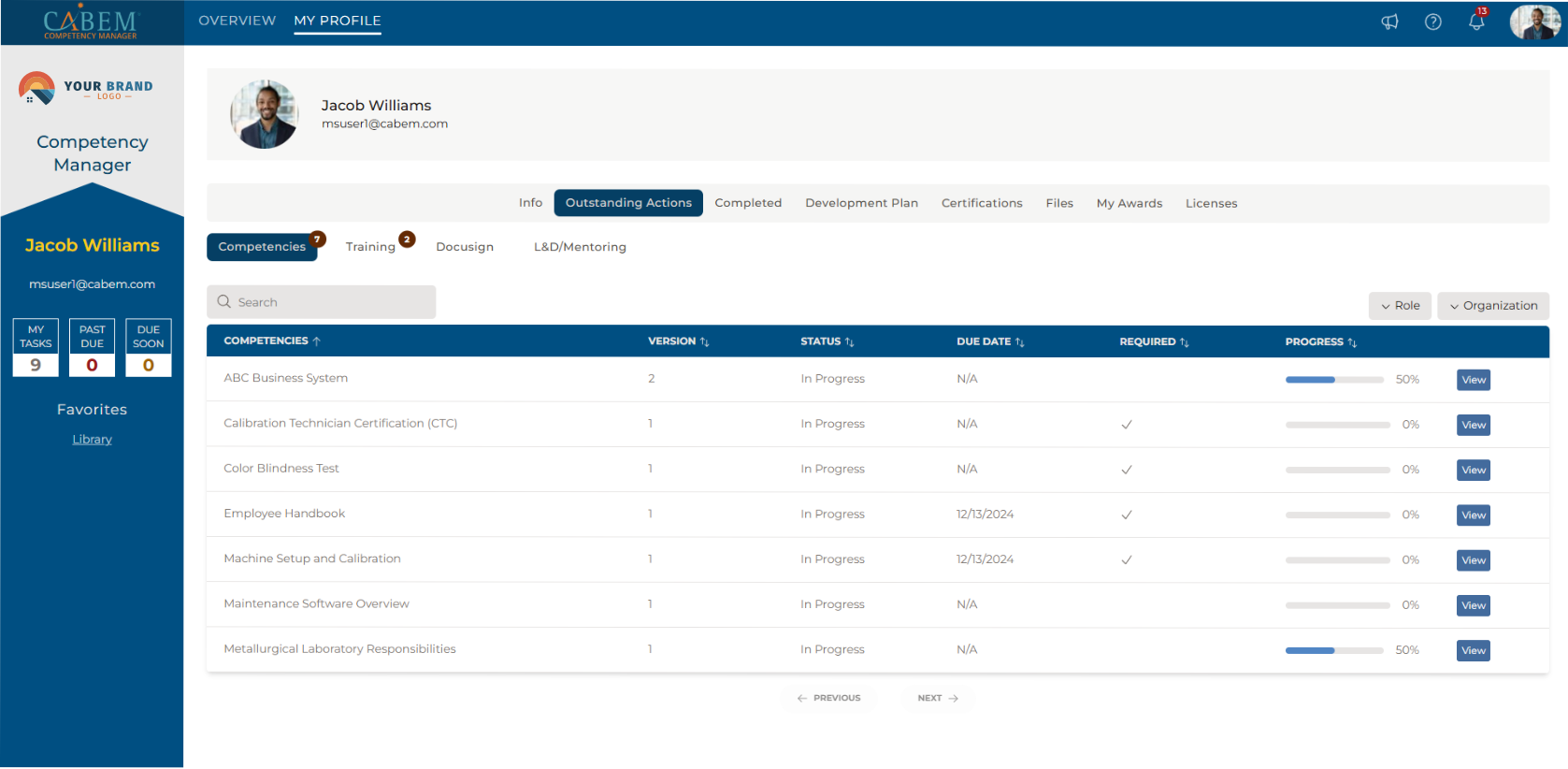
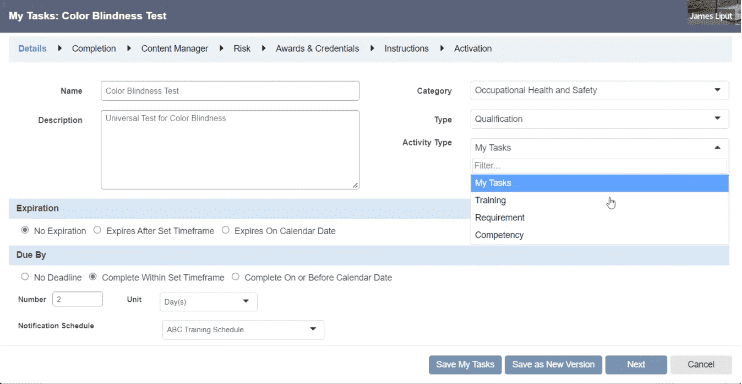
Set the requirement and the configurable options for managing the Activity.
Once an Activity is set up with all of the necessary requirements – the Completion Method must be assigned. Use one completion method, or many, and sequence them as needed.
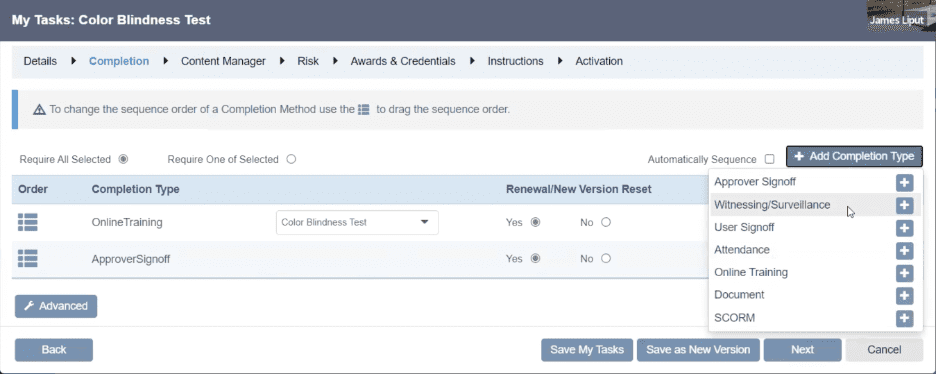
Competency-based Training Confirmation Methods
One of the key differentiators of CABEM’s Competency-based Training Platform is the variety of learning completion methods available within the system that can stand alone or be aggregated as workflows to satisfy competency requirements and expectations. Examples include User/Manager/SME approvals, performance assessments, proficiency scales, mentor oversight, automated expiration and renewal of certifications, event attendance, and proof through required upload of documentation. The built in LMS includes test taking, video playback, instructor led training and guided learning. Employees avoid missing key deadlines with automated notifications. Users are alerted to new and overdue competencies, certification renewals, and approaching requirements and trainings.
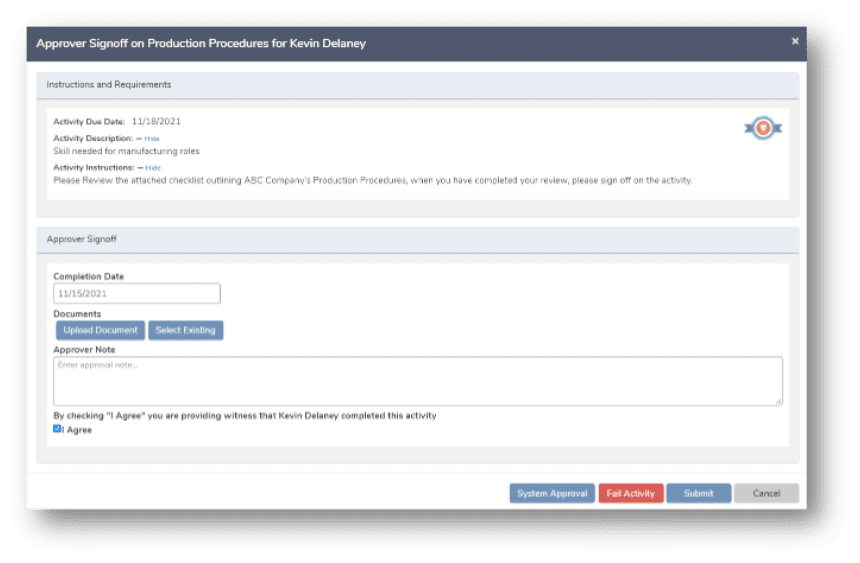
Approver Sign-off
Ensure oversight across the organization by requiring approver signoff as a simple standalone requirement or as a final task in a multi-step process, such as achievement of certification.
User Sign-off
Grow employee confidence and awareness on internal policies and external regulations by requiring user sign-off.
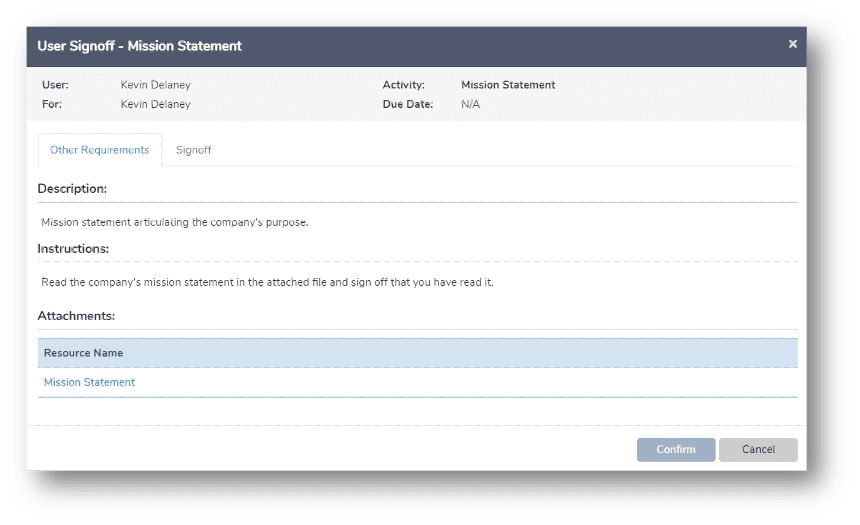
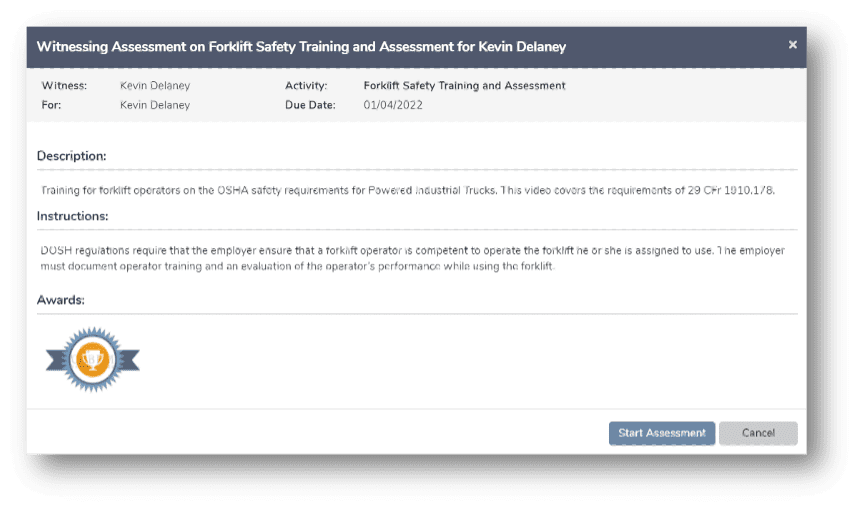
Witnessing
Capture experiential learning on-site through Witnessing. Subject matter experts can quickly and easily administer on-the-job training through custom assessments. All the information needed is recorded in the system via multiple formats like video upload. Move beyond checking boxes to make an impact on the behavior, culture and values across your organization.
Online Training
With the built-in LMS, you can build tests to quiz your learners at every point of the journey, leveraging a wide variety of question formats. Set passing percentages and define the number of attempts your learners have to retake quizzes. Administer required or optional standalone training courses or require them as steps to achieve competency or certification.
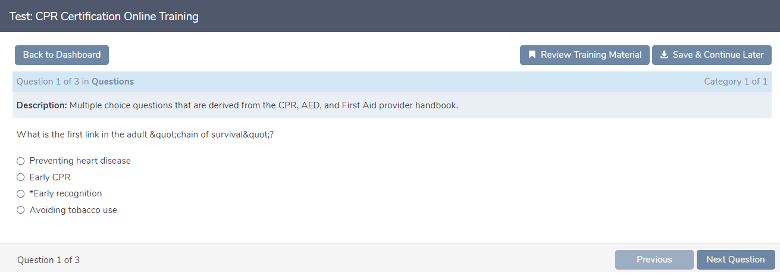
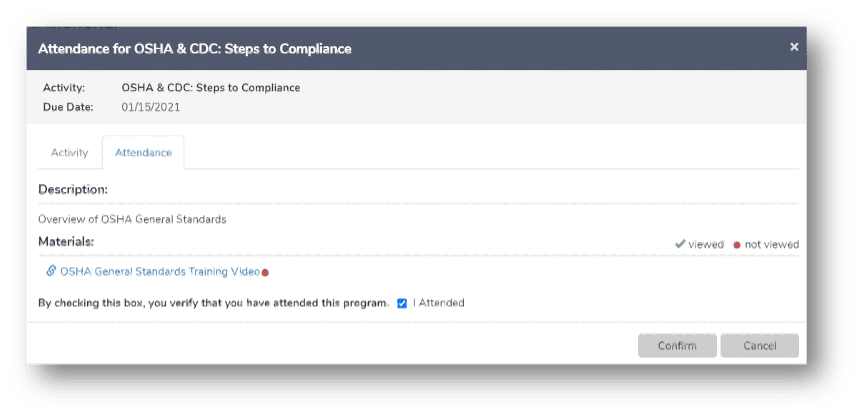
Attendance
Track event attendance at instructor-led training courses, community outreach, or instructional webinars.

Documentation
Require document upload to maintain proper employee training, certification, and compliance records. Quickly verify whether an individual or project team has all the documentation required for their work and provide evidence of certification to auditors, vendors, customers, and suppliers.
Surveys
Leverage the competency manager’s built-in survey features to learn and adapt your learning and competency program accordingly.

Activity Grids & Reporting
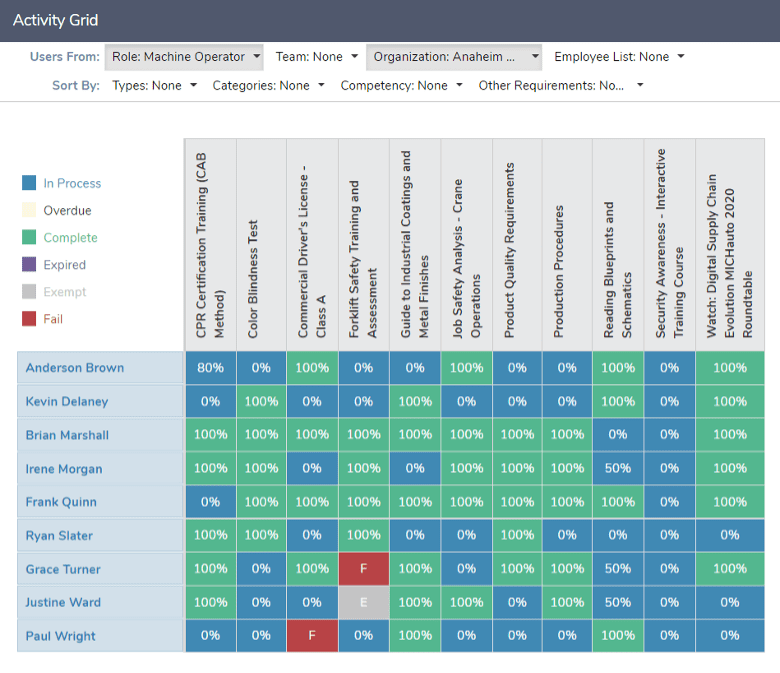
CABEM’s Competency Manager includes powerful reporting capabilities out of the box. The interactive Activity Grid matrix is a skills inventory that makes it easy to zero in on user progress toward completion. The Activity Grid allows Managers, Mentors, and System Administrators to view the details of a user’s progress for all assignments, as well as the ability to act through approval signoffs, assessments, and multiple other actions right from within the same screen. Discriminating filters provide the most efficient way of accessing important business intelligence in real-time.
Additional Reporting
With built-in reporting the Gap Analysis, Activity Metrics, Training metrics, Risk Analysis, or Role Compliance reports will give you the feedback you need to make sound business decisions or pass your upcoming audit.
Automate Your Competency Framework
Automate your current or newly designed competency framework with simple or more complex multi-step competencies, certifications, trainings, and regulatory compliance requirements. Multiple workflows accommodate sequencing for prerequisite tasks, such as self attestations, manager approvals, document uploads, in addition to evaluations and trainings.
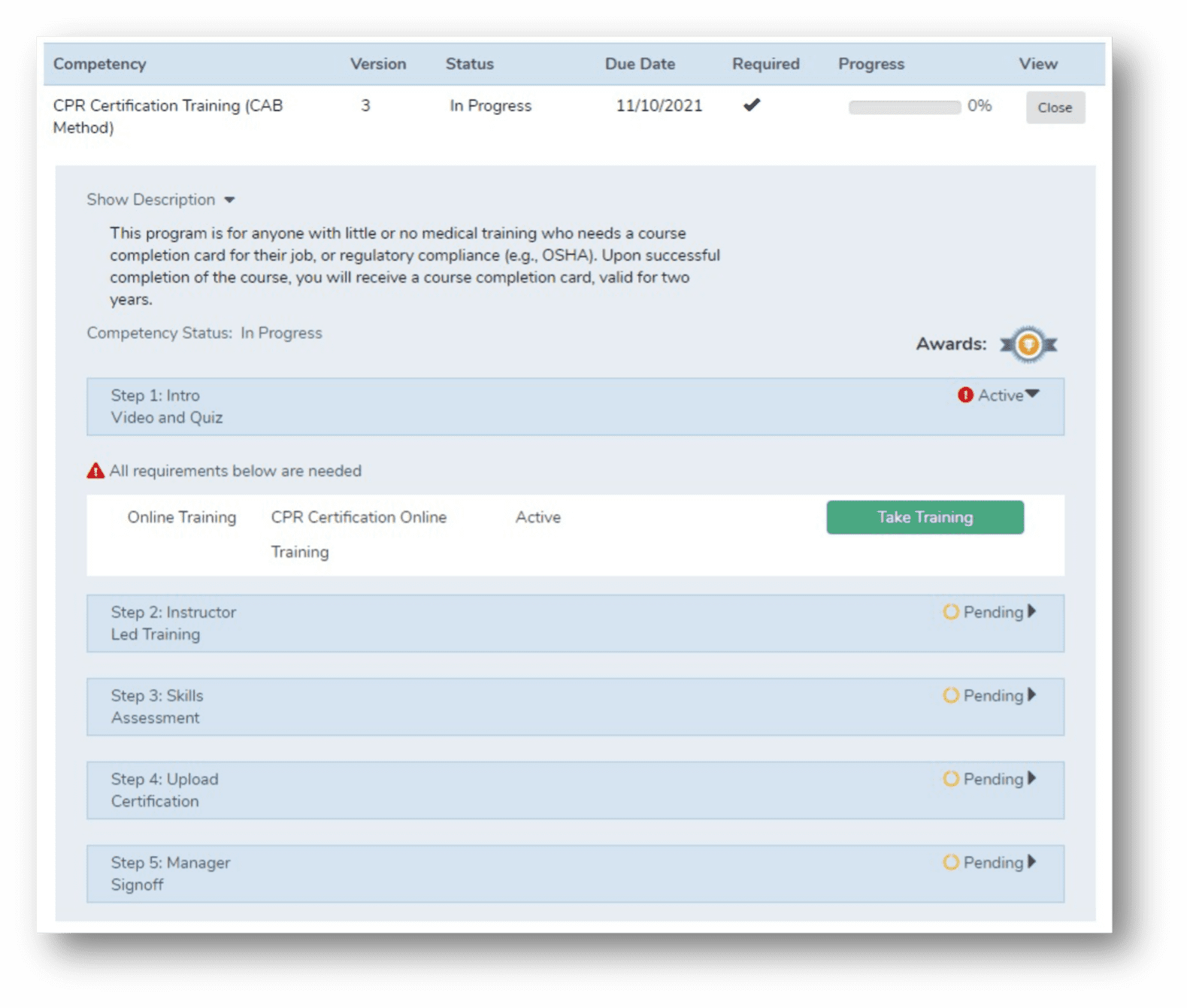
Integrate or Unite to Build Better
At our core, we are a custom software company. We are comfortable addressing any unique technical requirements a customer may have, including integrations between systems.
We can tailor fit the product to any needs of the customer. Current integrations include HRIS systems, SSO, Active Directory, Primary Source Verification, DocuSign, and multiple training platforms.
Onboarding and Acquisitions are made more efficient for the Enterprise with the CABEM Competency-based Training. It is scalable to accommodate growing organizations. It facilitates efficient group onboarding, and assignments, and quickly administers competencies by Roles, Teams & Special Projects, and Organizational groups such as location and department. New employees, locations, departments and associated trainings, competencies and information are added through an API integrations or CSV upload.
Competency Manager FAQs
What is Competency Manager?
Competency Manager is CABEM’s workforce competency and compliance solution designed to help organizations define role-based expectations, verify skill readiness, and maintain defensible records for audits and quality assurance. Instead of relying on spreadsheets and scattered training files, Competency Manager centralizes competencies, training, assessments, certifications, and reporting — giving leaders real-time visibility into readiness and risk.
What types of organizations use Competency Manager?
Competency Manager is built for organizations where performance and compliance matter — especially in regulated or high-stakes environments. It’s commonly used by healthcare systems, manufacturers, government agencies, and operational teams that need reliable proof of competency across roles and departments. The platform supports complex organizations with multiple departments, locations, and job types — and helps standardize workforce readiness at scale.
What’s the difference between training tracking and competency management?
Training tracking tells you whether someone completed a course. Competency management tells you whether they can perform safely and effectively in their role — and whether you can prove it. Competency includes validated assessments, observed performance, certifications, role expectations, and ongoing review. That distinction matters during audits, accreditation, and quality reviews because regulators often want proof of capability, not just attendance. Competency Manager helps organizations bridge that gap by connecting training to measurable competency outcomes.
How does Competency Manager help with audits and compliance?
Competency Manager helps organizations stay audit-ready by keeping competency records organized, current, and easy to report on. Leaders can track requirements by role, confirm completion of certifications and assessments, and generate defensible reports that show workforce readiness across teams. This reduces last-minute scrambling because competency evidence is collected and maintained continuously — not assembled under pressure. Many teams use Competency Manager to reduce audit risk and shorten audit preparation time significantly.
Can Competency Manager support multiple facilities, departments, or locations?
Yes. Competency Manager is designed to support organizations with multiple departments and locations. You can standardize role expectations across the organization while still allowing flexibility where policies, equipment, or workflows differ. Leadership gains a consistent view of competency status across teams, while managers can track and manage requirements specific to their department. This is especially valuable for healthcare and manufacturing organizations where consistency and proof matter across sites.
Can we customize Competency Manager to match our workflows?
Competency Manager is built to be configurable, so most organizations can align the platform to their roles, competency requirements, workflows, and reporting needs without heavy development. If integrations or unique workflows are required, CABEM can support those through services and scoped enhancements — while keeping the core system stable and easy to maintain. The goal is to fit your operation without turning the solution into a custom software project.
How long does it take to implement Competency Manager?
Implementation timelines vary based on organization size, number of roles, and how much existing content needs to be organized. Many teams start by launching one department or facility first, then expand in phases. CABEM’s approach focuses on clarity upfront — defining roles, requirements, and workflows — so adoption is smooth and reporting is meaningful. The fastest implementations are often the ones that prioritize a phased rollout with strong internal ownership and training.
What does onboarding and support look like after go-live?
CABEM doesn’t disappear after launch. We provide onboarding, training, and ongoing support to ensure Competency Manager is adopted and delivering value over time. That includes helping teams refine workflows, optimize reporting, and stay current as roles, regulations, and requirements change. Many organizations view CABEM as a long-term partner — ensuring competency management stays aligned with operational realities and compliance needs.
Does Competency Manager reduce administrative workload?
Yes — one of the biggest benefits is reducing the time managers spend chasing documents, tracking training manually, and piecing together reports. Competency Manager centralizes requirements, automates reminders and tracking, and makes it easier to see what’s complete and what needs attention. Instead of managing competency through spreadsheets and email, teams gain a single source of truth that supports efficiency and accountability.
How does CABEM ensure the system is secure and reliable?
CABEM builds solutions for regulated and mission-critical environments, where security and reliability are non-negotiable. Competency Manager is designed with strong access controls, data integrity principles, and audit-friendly reporting. CABEM also supports secure implementation practices and ongoing support to ensure the platform remains stable, compliant, and aligned with operational requirements. If your organization has additional security requirements, CABEM can address those during discovery and onboarding.
What’s the difference between Competency Manager and a generic LMS?
A learning management system (LMS) primarily tracks training activity — courses assigned and completed. Competency Manager focuses on verifying readiness: role expectations, assessments, observed performance, certifications, and defensible proof. Many organizations use an LMS for learning delivery and Competency Manager for compliance-grade competency tracking and reporting. If needed, CABEM can help connect systems so training activity supports competency outcomes without duplicating work.
How do we get started with Competency Manager?
The best way to start is a short conversation about your goals and pain points: audit readiness, workforce readiness, quality assurance, or standardization across teams. CABEM can help you evaluate fit, define a rollout approach, and identify quick wins for early impact. Whether you’re replacing a manual system or expanding an existing program, we’ll help you build a plan that makes adoption easier and results measurable.
Headquarters
2000 Commonwealth Avenue
Suite #215
Auburndale, MA 02466
Cybersecurity Services
3270 Blazer Pkwy Suite #101
Lexington, KY 40509
Phone
WWW.CABEM.COM

